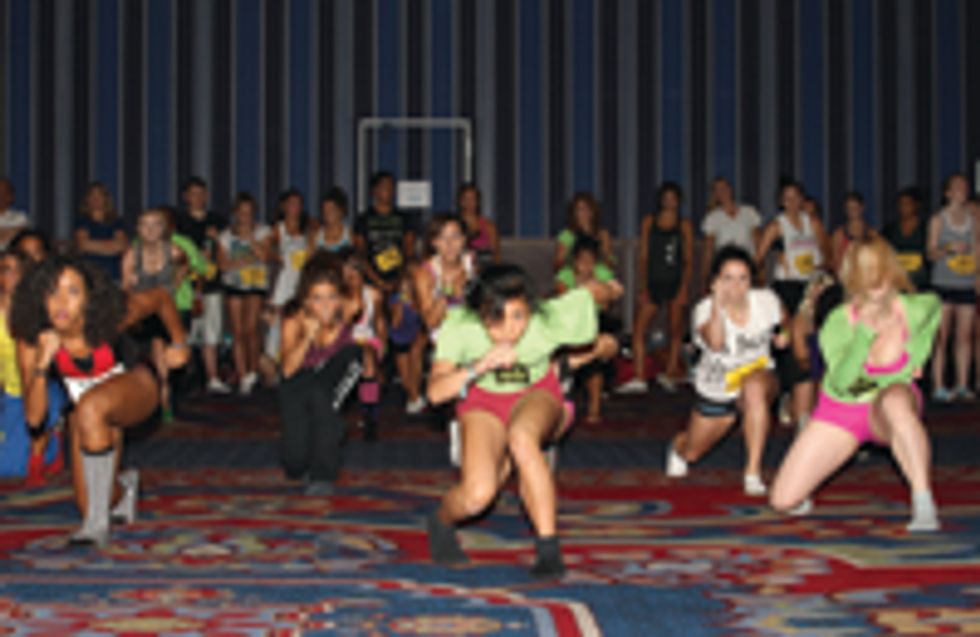Scholarship Savvy
When Chelsea Thedinga was 16, she won a scholarship from West Coast Dance Explosion that gave her a passport to attend as many of the company’s regional events as she wanted for an entire year. Spending extra time in WCDE’s convention classes helped Chelsea, now 20, make a lasting impression on the faculty. She even snagged a coveted assistant gig for the next season. As a WCDE assistant, she bonded with choreographer Stacey Tookey, whom she now assists regularly on “So You Think You Can Dance” and at music video shoots for artists including Christina Perri.
“Being in that environment helped my career take off,” says Chelsea, who has also worked with Sonya Tayeh and Travis Wall, thanks to relationships formed through other convention scholarships. “The more cities you can go to and the more you can get in front of the choreographers, the more it will benefit you.” Even if you don’t win a scholarship, Chelsea says, the convention scholarship audition experience itself is valuable. “The audition process is exactly the same as it is in the professional world: learning the combination, picking up the 8-counts, polishing the routine in groups and having to sell it to the judges,” she says.
Not sure what to expect from your next convention scholarship audition? Read on for some insider tips to help you make the best possible impression on the judges.
Convention Scholarships 101
Many types of scholarships are available, with some conventions awarding as many as 15 per age division in each city. At regionals, dancers can often win scholarships like Chelsea’s, which allow free access to events in other cities. Some conventions also provide “agency awards,” where dancers are offered meetings with top dance agents. Another common award is a studio scholarship, which typically grants a series of free classes at high-profile studios, like L.A.’s Millennium Dance Complex or NYC’s Broadway Dance Center.
A few companies, like The PULSE on Tour, consider the entire weekend to be an audition, with dancers wearing numbers in every class. However, most have a stand-alone audition, commonly held on the second day of a convention weekend. Usually anyone registered for the full convention can audition for scholarships. These auditions frequently follow a similar format, but some teach a ballet or jazz combo only, while others incorporate multiple genres. Since auditions can have more than 100 dancers, judges (usually members of the convention faculty) often have multiple rounds of cuts.
Audition Prep
-
Polish your ballet technique.
Matt Dorame, a teacher and judge for L.A. DanceMagic, says it’s important to hone basic classical moves, like pirouettes, arabesques and pas de bourrées, before attending a scholarship audition. “I want to see that you’re in ballet class more than once or twice a week,” he says. -
Know your terminology.
When Dorame teaches the ballet combo during an audition, he often throws in a few moves without demonstrating, just to make sure dancers have a grasp of the lingo. -
Familiarize yourself with faculty.
Check out the convention’s faculty list and search for the teachers’ choreography videos online, suggests Christopher Smith, director of Hollywood Vibe. “Seeing their body of work will give you an idea of what to expect at the audition,” he says.
During the Convention
-
Class it up.
Face time is crucial if you want to make an impression on convention faculty. So even if you’re not a tapper, be sure to take a tap class if it’s on the schedule. “Being noticed in every class plays a key part in the scholarship audition,” Chelsea says. -
Act professionally.
Your demeanor in class is just as important as the way you act at the audition. The faculty is always observing dancers for scholarship consideration. “If it comes down to two people who are equally talented, I’ll pick the person who’s had a good attitude all weekend,” says Tina D’Amato-Sidoni, a teacher for Hollywood Vibe. -
Make connections.
Forming relationships with faculty throughout the weekend can be key to making sure the teachers recognize you at an audition. Brittany Andres, winner of The PULSE on Tour’s Elite Protégé title in 2009, makes a point of thanking choreographers after class.
At the Audition
-
Look the part.
Try to choose attire that will make you distinctive in a crowded ballroom and that will show off your lines. Brittany sets herself apart with bright colors, and Chelsea likes body-conscious leotards and booty shorts. Keep it classy by choosing form-fitting items with conservative cuts. -
Assess the conditions.
At many conventions, you may have to dance on carpeting or a crowded dance floor in a hotel ballroom. Check out the space and practice beforehand so you’re prepared. -
Show your stuff.
Standing in the front of the room can be a smart move, but don’t be too aggressive: “The people fighting to be seen are more of an irritation for the judges than anything,” says Dorame. Try to be confident and enjoy the moment.




